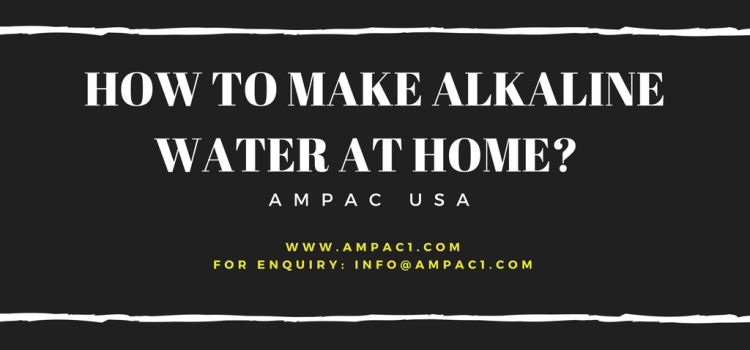Last updated on June 7th, 2025 at 03:35 pm
In today’s health-conscious world, alkaline water has emerged as a favored choice among those seeking improved hydration, detoxification, and a balanced pH. As we strive to neutralize the acidic nature of modern diets, learning how to make alkaline water at home provides a cost-effective and accessible way to enjoy its benefits daily. In this guide, we uncover precise methods, tools, and tips to prepare alkaline water without the need for expensive machines.
What Is Alkaline Water?
Alkaline water is water with a higher pH level than regular tap water. While standard drinking water has a neutral pH of around 7, alkaline water typically ranges from pH 8 to 9.5. It may also contain alkaline minerals such as calcium, potassium, magnesium, and bicarbonate, which contribute to its potential health benefits.
Read: The Most Effective Way to Eliminate PFAS and PFOA from Your Drinking Water
Health Benefits of Alkaline Water
Before diving into the preparation process, it’s crucial to understand why people drink alkaline water:
- Balances body pH: Helps reduce acidity caused by stress, processed foods, and environmental toxins.
- Improves hydration: Molecules are believed to be more easily absorbed at higher pH.
- Boosts energy levels: Enhanced hydration may improve energy and reduce fatigue.
- Supports detoxification: Assists in flushing out harmful toxins from the body.
- Improves bone health: May reduce bone resorption and support calcium retention.
Tools and Ingredients Needed To Make Alkaline Water
To create alkaline water at home, you may need the following:
- pH test strips or digital pH meter
- Baking soda (sodium bicarbonate)
- Lemon (or lime)
- Himalayan pink salt or sea salt
- Mineral drops
- Filtered or purified water
- Alkaline water filter pitchers or ionizers (optional)
Read: EPA Sets First Federal Limits on Dangerous ‘Forever Chemicals’ in Drinking Water
Method 1: Using Baking Soda
Ingredients:
- 1 liter of filtered water
- 1/2 teaspoon of baking soda
Instructions:
- Add baking soda to the filtered water.
- Stir thoroughly until the powder completely dissolves.
- Use pH test strips to ensure the pH is between 8–9.5.
- Store in a clean glass container and drink within 24 hours.
Why It Works:
Baking soda is naturally alkaline with a pH of around 9, making it a reliable and affordable solution for quick results.
Method 2: Infusing with Lemon and Himalayan Salt
Despite being acidic in nature, lemon has an alkaline effect once metabolized.
Ingredients:
- 1 liter of filtered water
- 1 lemon (sliced, not squeezed)
- A pinch of Himalayan pink salt
Instructions:
- Slice the lemon and add to a jug of water.
- Add a pinch of Himalayan salt.
- Let the mixture sit overnight (8–12 hours) at room temperature.
- Test the pH the next day; it should be around 8.
Why It Works:
The minerals in Himalayan salt and the metabolic properties of lemon create a naturally alkalizing effect without adding artificial substances.
Method 3: Alkaline Water Filter Pitchers
What It Is:
Alkaline water pitchers are equipped with multi-stage filters containing ceramic balls, activated carbon, and mineral-infusing media that raise the pH of water.
How To Use:
- Fill the pitcher with tap or filtered water.
- Let it filter through the alkaline cartridge.
- Check the pH level with test strips.
Pros:
- Convenient and reusable.
- Reduces chlorine, heavy metals, and raises pH.
Recommended Brands:
- Ehm Ultra Premium
- Invigorated Water pH Restore
- Seychelle pH2O
Method 4: Using pH Drops or Mineral Drops
Ingredients:
- Filtered water
- pH booster drops (commercially available)
Instructions:
- Add 2–3 drops of pH booster to a glass of water.
- Stir and test the pH to confirm.
- Drink immediately.
Advantages:
- Portable and ideal for travel.
- Precise control over pH levels.
Popular Products:
- AlkaZone pH Booster Drops
- Balance7 Alkaline Drops
Method 5: Electrolysis Using Water Ionizers
What It Does:
A home water ionizer connects to your tap and passes water through electrodes to separate acidic and alkaline components.
How To Use:
- Connect to your faucet or under the sink.
- Select your desired pH level (typically between 8 and 10).
- Collect and store the ionized alkaline water.
Considerations:
- Higher upfront cost.
- Requires regular maintenance.
Read: $3 Billion for Lead Pipe Replacement to Deliver Clean Drinking Water
Best Practices When Making Alkaline Water
Use Purified or Filtered Water
Start with clean, contaminant-free water to ensure safety and purity.
Test Your Water pH
Use pH testing strips or digital meters for accuracy. The ideal drinking water pH is 8 to 9.5.
Avoid Over-Consumption
Excessively high pH water can disrupt stomach acid. Limit intake to 1–2 liters per day, especially if new to alkaline water.
Store Properly
Use glass containers to prevent chemical leaching. Avoid plastic or metallic bottles.
Alkaline Water for Specific Uses
Post-Workout Hydration
Helps replenish electrolytes and neutralize lactic acid.
Cooking
Using alkaline water for rice, pasta, and vegetables enhances taste and texture.
Skincare
Some use alkaline water as a facial mist or rinse to help with dry or irritated skin.
Myths About Alkaline Water
- “Alkaline water cures diseases”: There is no scientific evidence proving it treats chronic conditions.
- “All alkaline water is the same”: Natural mineral-infused water differs from chemically altered versions.
- “More alkaline is better”: Extremely high pH can lead to alkalosis, an imbalance in body chemistry.
Conclusion: Transform Your Water, Transform Your Life
Learning how to make alkaline water at home empowers you to take control of your hydration and health. Whether you opt for natural methods using lemon and salt, DIY baking soda solutions, or invest in filtration systems, each method offers a simple way to improve water quality.
By maintaining optimal hydration with the right pH, we support our body’s vital functions, reduce internal acidity, and take one step closer to holistic wellness—one glass at a time.











Your point of view caught my eye and was very interesting. Thanks. I have a question for you.
I don’t think the title of your article matches the content lol. Just kidding, mainly because I had some doubts after reading the article.